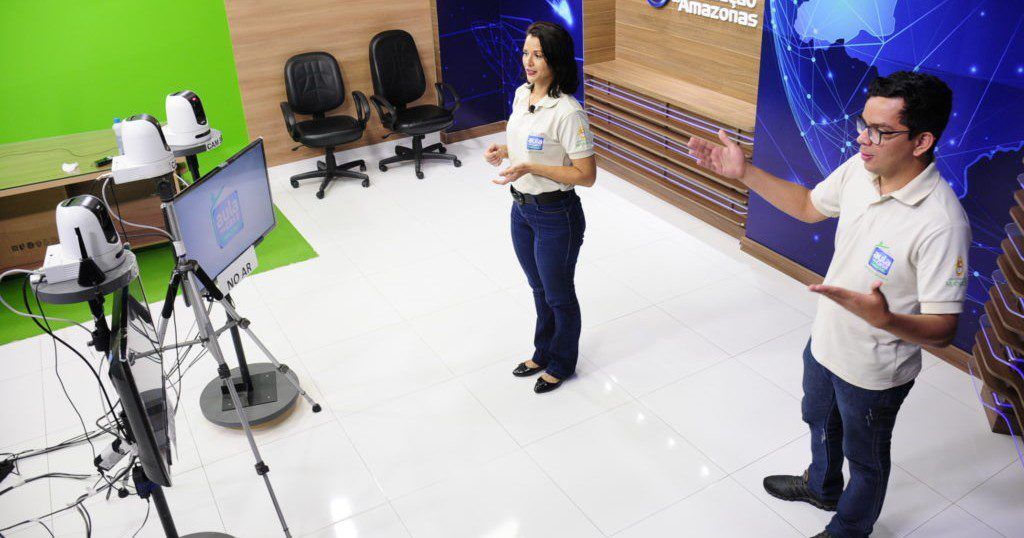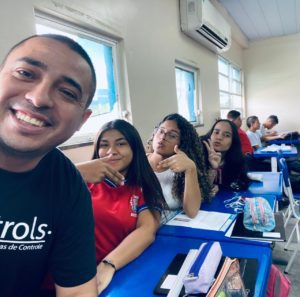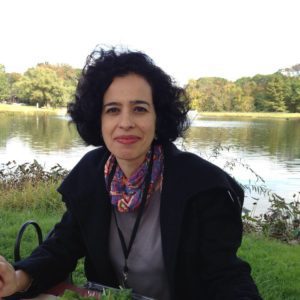
How the Amazon region, hardest-hit by coronavirus, resumed lessons with classrooms closed
Aula em Casa is a project launched by the department of education of Amazonas state. It reaches 450,000 students in the state and has recently expanded into other Brazilian states of São Paulo, Sergipe and Espírito Santo, which means it brings its content to millions of schoolchildren.
Like millions of other students in Brazil, Pedro Henrique Oliveira Cantuario found himself stuck at home, without having a chance to go to school. It is not like he is pining to get back into the classroom. But he is badly missing his friends, teachers and extracurricular activities.
Schools have been closed in Brazil since mid-March. For Pedro, 17, who lives in Manaus, the capital and largest city of Amazonas state, it means watching TV. No, he is not lazy. It is because his school has become television.
Brazil has the world’s second-highest number of Covid-19 cases and has recently had more new deaths than any other nation. When the coronavirus reached the country, Amazonas has become one of the hardest-hit regions. It was crucial to close schools to stop the pandemic. Within less than a week after the official decision to suspend in-person classes, students were able to resume their schooling. Even though this enormous, jungle-flanked state was poorly prepared for the virus, it already had enough TV lessons for students in all grade levels and subjects, including math, social studies, and science.
It turned out that the challenge of teaching in isolated and remote areas has become an advantage.
A classroom at home
In 2007, the Amazonas Secretariat for Education (SEDUC) launched a programme to reach communities where specialised teachers were not available. Lessons are prepared by the Center for Media Education (Centro de Mídias) in Manaus that employs around a hundred teachers and technicians.

They transform a curriculum into a screenplay, record it in a television studio, add visuals to make it more attractive, and put everything together in pre-recorded video classes for elementary and high school students that are later transmitted via satellite deep in the heart of the Brazilian rainforest.
A televised class is supported by a generalist teacher or an onsite tutor reinforcing lessons in rural communities. In 2009, the project received the WISE Awards. According to the World Bank data, by 2013 it reached 38,000 students in 2400 communities.
So, when schools were closed due to the pandemic, SEDUC simply started airing the content on two open television channels, in addition to YouTube, a Mano app and a website. It is called Aula em Casa that means “a classroom at home.” It reaches 450,000 students in Amazonas and has recently expanded into other Brazilian states of São Paulo, Sergipe and Espírito Santo, which means it brings its content to millions of schoolchildren.
“It is a completely different situation from the rest of the world where people have broadband access,” says Luis Fabian Barbosa, the secretary of state for education.

In Amazonas, many families living in remote regions do not have access to the Internet or computers. Instead, 97 per cent of households have TV, as SEDUC data shows. “Therefore, it was vital to establish a partnership with open television channels to broadcast Aula em Casa for free. Besides, there is a culture of watching television in Brazil. It is very popular, so we knew that it would reach most people,” explains Luis Fabian Barbosa.
“Imagine how many hours we have already recorded in 13 years of the project. We just used it,” Barbosa adds.
School on a screen
Pedro, a student at Centro Educacional de Tempo Integral Gilberto Mestrinho, a public school in Manaus, says that he’s been studying hard while watching Aula em Casa. It is his final year of high school, and he hopes to enter university after graduation and become a biology teacher. He can generally follow the curriculum. “But sometimes it’s not easy to understand some parts of these classes. Whenever I have problems with a certain subject, I call my actual teachers at school, and they explain it to me via cellphone,” says Pedro.
Aula em Casa is organised in a way that apart from theory, students are asked to complete assignments while watching. When a class is aired, they can rewatch it on the next day, in addition to having it published online. Pedro also receives assignments from his school teachers, which they submit in Google Classroom or via WhatsApp.

It is not the first time when he does not go to school. Last year, when teachers went on strike over their low salaries, there were no classes for more than a month. “It is much better with Aula em Casa that allows me to study. I don’t feel alone,” says Pedro. What he would improve is to bring interaction to those video lessons and motivate students to attend classes.
Getting children to virtual school
Chronic absenteeism is a problem in education during the best of times, so how is a TV school dealing with it?
According to SEDUC, there are disparities in attendance rates between the capital and rural areas, where there’s a higher degree of absence. Luis Fabian Barbosa estimates that in the capital, around 80 per cent of students participate in online or televised classes. In some of the most remote areas, this number may get as low as 40 per cent.
“It happens for several reasons,” he says. “Firstly, families in rural areas have more than one child, but only one TV set. We, therefore, had to rethink our schedule in a way that lessons for all grades are aired at different time slots.”
Barbosa explains to me that the further from the city, the less control schools have over their students. In the capital, teachers can check their pupils online or call their parents. But in rural areas, where there is no connectivity, teachers have to come to their students’ homes and inform, guide and sensitise parents about the importance of following televised classes.
Alécio Gaigher, who teaches English at CETI Gilberto Mestrinho in Manaus, says that he and other teachers distribute a document through Google Classroom for students to check their attendance. If someone is absent, a school takes action and usually calls the students’ parents. Gaigher also uses WhatsApp to contact his students directly, as many of them have this messaging service included in their mobile plan.
As I was told by SEDUC, it is the teachers and schools’ role to monitor attendance.
“A great majority of my students usually do their assignments and learning activities, but I have to be creative and interact with them all the time,” Gaigher says. He used Instagram to deliver content and engage with his students in real-time. “I am very pushy, so I have a high rate of attendance,” he laughs.
It comes with a price that many other teachers around the world are currently paying: their workdays do not end at traditional bell hours. They reply to their students’ questions or send everyone personalised feedback till late evening.

João Marcelo, a high school teacher at CETI Gilberto Mestrinho, uses educational apps like Kahoot for do-nows or review. He says that Aula em Casa made his work easier because students are learning through it. Marcelo refers and follows up on a class his students watched by sending them additional materials, assignments and quizzes.
Only television is not enough
Brazil has a long tradition of using television to bring education to those who were not able to attend school, which dates back to the 1960s.
The experience in distance education provided by Amazonas state is “successful”, assesses Jhonatan Almada, director of the Center for Innovation and Knowledge for Excellence in Public Policies (CEIP), a São Luís-based think tank that investigates and researches public policies in education and technology.
Almada is cautious, though. “What is the quality of public education offered in the state of Amazonas? Official data indicates that only 3 out of 10 children learned the adequate Portuguese language, and only 1 out of 10 learned the adequate in mathematics by the end of primary school. It is what Aula em Casa was not able to solve,” he explains.
Aula em Casa, therefore, needs to invest heavily in monitoring and evaluation, because the lack of face-to-face mediation by teachers will damage students’ performance, believes Almada.

Indeed, the role of mediators is increasing in both learning and coping with the situation, says Mirela Ramacciotti, a researcher in interdisciplinary education, neuroscience and applied psychology. Mediators are teachers, parents or anyone who can help a schooler during the learning process.
“It is an illusion that we can put a child in front of a TV and expect from her or him to do the work alone,” Ramacciotti explains. “The child will be entertained, but not absorbed, because learning needs to be active, guided, instructed.”
Curiously, it applies to all three age groups she discussed: children younger than six years, those between seven and eleven, and teenagers in high school. Their level of self-regulation and independence may differ, but they need to be supervised.
“But if there’s anything positive that this pandemic brought us, it is the recognition of parents’ role in the learning process,” Ramacciotti believes. For years, caregivers were excluded or preferred to stay away from their children’s education. Yet they are instrumental in stimulating and motivating to learn, helping with unclear issues and providing detailed feedback. Not surprisingly, they are also crucial in how a child is coping with the pandemic situation.
She explains that television also helps preserve routine and rituals that children need. But TV or online classes are not enough, simply because “we learn from others, through others and with others.”
Hybrid solution
SEDUC decided not to reopen schools in the Amazonas until the pandemic is controlled, and it is safe for students to return to classes. However, as Barbosa explained to me, there will be a rotation system between home-based learning with Aula em Casa and returning to school for lessons. It is to reduce the number of students at school at any one time for “better physical distancing”.

The curriculum that is being taught via Aula em Casa was adapted to make it aired simultaneously and at the same order. However, once schools are open, then reviewing, testing and assessing starts. SEDUC plans to employ social workers and mental health therapists to help students with their emotional well-being. The money for this will come from the school maintenance and students transportation budget that was not used during the lockdown.
Barbosa stressed that Aula em Casa did not cost the educational authorities anything since lessons were recorded by the Center for Media Education in Manaus. He says that the pandemic made them rethink their practices. “I believe more teachers will now be willing to use technology in education. It was not always the case before.”























